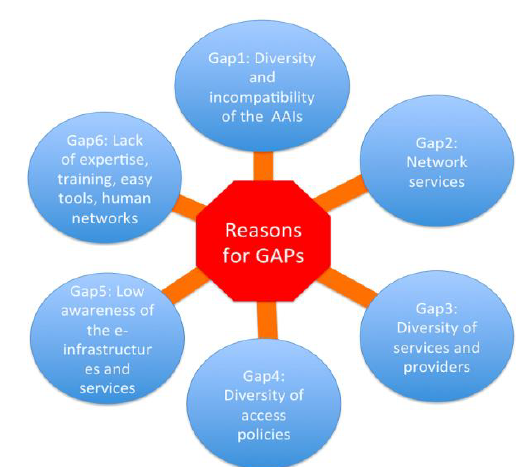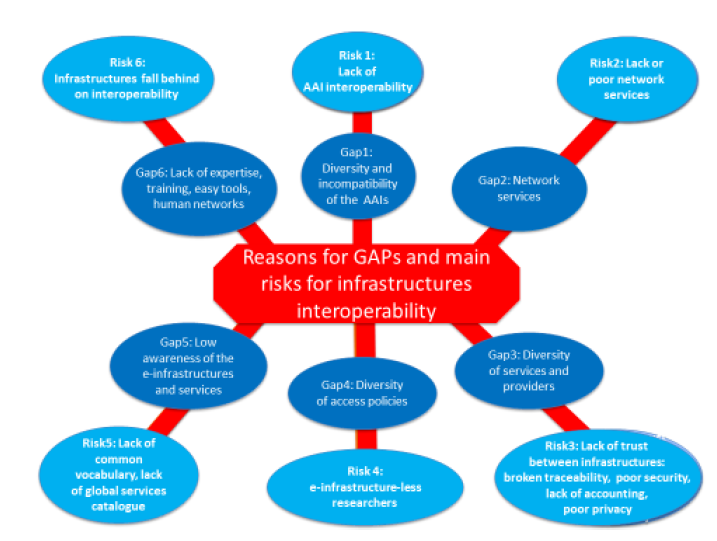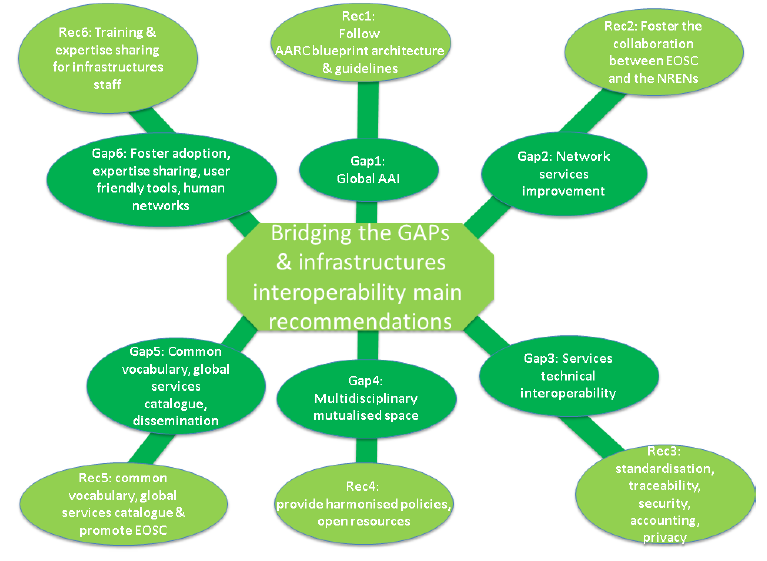EOSCpilot’s Contributions to EOSC Interoperability
The success of the EOSC relies strongly on the ability to interconnect data and e-infrastructures, necessary to serve the diverse landscape of European research infrastructures. The EOSC interoperability heavily relies on the EOSC architecture capacity, which allows not only data-sharing between cross-disciplinary, but also ensures a high degree of re-usability. The FAIR principles are considered a key to the construction of the EOSC, since they provide guidance and overcome the fragmentation and inefficiencies that increase data reuse effectively. A gap analysis on technical and political barriers that prevent the interconnection of e-infrastructures and the application of FAIR principles was performed.
6 Gaps preventing EOSC's Interoperability

- GAP 1: Diversity and incompatibility of the Authentication/Authorisation Infrastructure (AAIs);
- GAP 2: Network services;
- GAP 3: Diversity of services and providers;
- GAP 4: Diversity of access policies;
- GAP 5: Low awareness of the e-infrastructures and services;
- GAP 6: Lack of expertise and training.
Access the "e-Infrastructure Gap Analysis" Report now!
6 Risks preventing Infrastructures' Interoperability
For each GAP, several elements have been identified as potential risks for e-infrastructures interoperability. Consideration of these elements needs to keep in mind the risk of decreasing or completely breaking the interoperability between infrastructures.

- A lack of AAI interoperability;
- A lack of network services or poor network services;
- A lack of trust between infrastructures, namely on traceability; security; accounting and GDPR compliance;
- A lack of information about services (end-user services and technical services), their description (catalogue) and information system from infrastructures.
14 Recommendations to ensure Infrastructure's Interoperability
Based on the gaps and risks, the following recommendations are proposed to ensure infrastructure interoperability in the context of the EOSC, for each of the six gaps.

GAP 1 Diversity and incompatibility of the Authentication/Authorisation Infrastructure (AAIs)
- Recommendation: Implementation of a federated AAI - adopt the AARC Blueprint Architecture and follow the associated guidelines.
GAP 2 Network services
- Recommendation: Foster the network collaboration between EOSC and the Research and Educational Networks (NRENs)
GAP 3 Diversity of services and providers
- Recommendation 3A: Infrastructures should describe their services in a standardised way, such as by using the eInfraCentral template.
- Recommendation 3B: Infrastructures should identify their services’ interoperability dependencies and to correctly describe these interdependencies.
- Recommendation 3C: Infrastructures should be able to provide complete accounting data, to take care of the users’ privacy, to provide traceability and to collaborate actively
- Recommendation 3D: The EOSC itself should organise security channels to ensure security and privacy at EOSC level, and ensure global traceability, and to set up the EOSC information system.
GAP 4 Diversity of access policies
- Recommendation 4A: EOSC should build a mutualised space (agnostic to discipline and geography) in order to serve all researchers, from all disciplines, in all countries
- Recommendation 4B: Consider how to harmonise access and usage policies, in order to minimise the conditions that users need to accept to be able to access resources within the infrastructure
- Recommendation 4C: EOSC should propose incentives to support funding agencies in making the resources they fund more openly available.
- Recommendation 4D: Infrastructures should define and publish applicable Service Terms of Use including acceptable usage policies in the EOSC Service catalogue as proposed by eInfraCentral
GAP 5 Low awareness of the e-infrastructures and services
- Recommendation 5A: The EOSC should promote the setup of a common vocabulary.
- Recommendation 5B: Disseminate and widely promote the EOSC at all levels of the European Research Area
GAP 6 Lack of expertise and training
- Recommendation 6A: Infrastructures should use the “EOSC Skills and Capability Framework” (D7.3)56.
- Recommendation 6B: Foster networking activities to share expertise and experience among infrastructure technical staff
Get to know the proposal for the Final EOSC Architecture and more detailed info on Recommendations for the EOSC interoperability. Access the report here
6 Recommendations to adapt FAIR data principles for the EOSC
The FAIR Data Principles are guidelines aimed that aim make data findable, accessible, interoperable and reusable. However, the interpretation and implementation of the FAIR principles varies across different domains and by data resources. Concerning EOSC, it is important to complement the FAIR principles with recommendations that improve the availability of research data to users and services through an open cloud infrastructure. The following set of six recommendations aim to prioritise and define specific solutions needed to build a coordinated FAIR data ecosystem.
- Recommendation 1: The data guidelines and technical solutions proposed by EOSC should be specific, common, simple, lightweight and collaborative;
- Recommendation 2. All the data resources comprising the EOSC should expose structured metadata;
- Recommendation 3. The EOSC should reuse existing standard formats promoting the use of common best practices across scientific domains;
- Recommendation 4. The EOSC should propose minimum information guidelines across scientific domains especially encouraging exposing key operational metadata important for services consuming data;
- Recommendation 5. The EOSC should support an interconnected system of metadata catalogues as a fundamental service component to facilitate data discovery;
- Recommendation 6. The EOSC should implement a monitoring service to validate standards and recommendations proposed by the EOSC.


